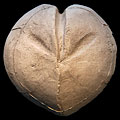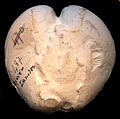The Echinoid Directory
Dipneustes Arnaud, in Cotteau, 1891, p. 623
| Diagnostic Features |
|
|---|---|
| Distribution | Paleocene (Danian) of southern France. |
| Name gender | feminine |
| Type | Dipneustes aturicus Arnaud, in Cotteau, 1891, p. 624, by original designation. |
| Species Included |
|
| Classification and/or Status |
|
| Remarks |
|



